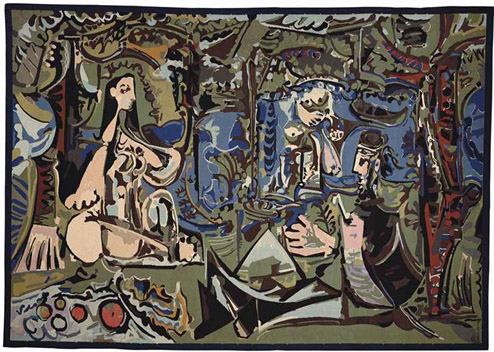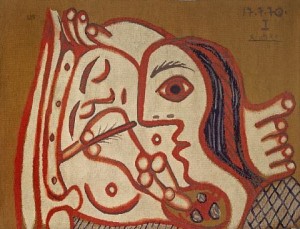
This Picasso tapestry woven by Durrbach, “Déjeuner sur l’herbe” was the most expensive auction sale of a Picasso tapestry when it sold for $420,000 in 2007. The same weaving was resold in 2014 for $289,572
Pablo Picasso (Spanish, active France – 1881 – 1973) was one of the artists from whom Marie Cuttoli solicited paintings to be translated in the medium of tapestry in the 1920s. Cuttoli, who was married to a French senator from Algeria, owned a fashionable shop in Paris and hoped to revive the fading workshops of Aubusson with new commissions by fashionable modern artists who also included Braque, Miro, Leger, Matisse, Dufy and others.
Though supported by important clients like cosmetics queen Helena Rubinstein and Dr. Albert C. Barnes, Cuttoli’s showing of tapestries together with the paintings they had been translated from was not a success, at least in terms of sales. Stung by the Depression, collectors found the tapestries too expensive and settled for the less costly paintings, which ironically are vastly more valuable today. Several of these early Cuttoli tapestries, including a Picasso and a Miro, are part of the famous Barnes Foundation in Philadelphia.
Picasso remained friends with Marie Cuttoli throughout their lives and worked on tapestry collaboration several other times throughout the years. Her collection of paintings which she donated to the Musée National d’Art Moderne included several images that were recreated in tapestry on more than one occasion throughout the years. Cuttoli later turned some of her Picassos into tapis — pile rugs and carpets.
Picasso, who insatiably explored virtually every artistic medium, was particularly enamored of the unique appeal of textiles. Through Cuttoli, Picasso tapestries were woven by various ateliers including Langouix, Saint Cyr, Pinton and by Yvette Cauquil-Prince who went on to work with Chagall, Max Ernst and others.

This late Picasso tapestry “Le peintre et son modèle” sold at Bonhams & Butterfields in 2010 for $39,650, but brought $132,0000 at Sotheby’s in 2006.
Perhaps the best known Picasso tapestries were those created in a partnership with Nelson Rockefeller. In the early 1960s Rockefeller entered into a business arrangement with Picasso whereby the two would select images to be woven into tapestries by Jacqueline de la Baume, the wife of Picasso’s friend and fellow artist René Dürrbach, in editions of three. Rockefeller would finance the project by buying one of each, Picasso would receive one and the last would be sold commercially. The most famous of these weavings is probably the tapestry after Guernica which for many years was on loan from the Rockefeller family to the United Nations in New York, where it hung many years outside the Security Council. Other Dürrbach Picasso tapestries are on display at the Rockefeller family estate, Kykuit in Pocantico Hills, New York and in various museums including the Art Institute of Chicago.
There are also Picasso wall hangings that are often called “tapestries” but which differ significantly from the rare and valuable textiles that are hand-woven in Aubusson. One that has achieved particular notoriety is the huge canvas theatre curtain that Picasso painted for the Ballets Russes in 1919 and which hung at the Four Seasons Restaurant in New York City. In recent decades various carpets and rugs (tapis) have been authorized by the Picasso Estate and produced, some by mechanical means and in large editions. These items are not in the same value category as true tapestries and unauthorized Picasso weavings are not unknown.
There is some controversy regarding market value of these rare items and buyers would be wise not to rely on a single source regarding pricing. See Buying Tapestries.
